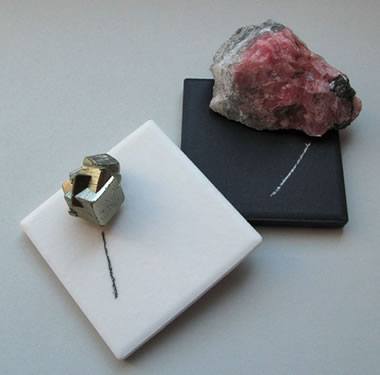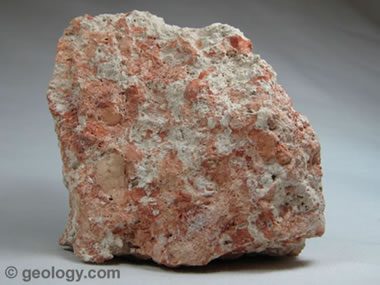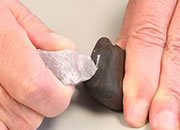The Streak Test for Minerals
Done by scraping the mineral across an unglazed porcelain streak plate.
Article by: Hobart M. King, PhD, RPG

The Streak Test: Marks, known as "streaks," are produced by scraping mineral specimens across unglazed porcelain plates. On the left, a specimen of pyrite has produced a black streak. On the right, a specimen of rhodochrosite has produced a white streak. Many minerals produce a white streak, and some geologists prefer using a black streak plate for these minerals because the mineral particles in the streak are easier to observe. This photo by Ra'ike is used here under a GNU Free Document License.
What is the Streak Test?
The "streak test" is a method used to determine the color of a mineral in powdered form. The color of a mineral's powder is often a very important property for identifying the mineral.
The streak test is done by scraping a specimen of the mineral across a piece of unglazed porcelain known as a "streak plate." This can produce a small amount of powdered mineral on the surface of the plate. The powder color of that mineral known as its "streak."
Streak Colors of Common Minerals |
|
| Andalusite | White or colorless (hardness is about the same as the streak plate). |
| Anhydrite | White. |
| Apatite | White. |
| Arsenopyrite | Dark grayish black. |
| Augite | White to greenish gray. Augite can be splintery and close to the hardness of the streak plate, so brittle fragments, rather than a powder, will sometimes be produced. |
| Azurite | Light blue. |
| Barite | White. |
| Bauxite | White. Often discolored to pink, brown, or red by iron staining. |
| Benitoite | White. |
| Beryl | Colorless (harder than the streak plate). |
| Biotite | White to gray (don't be deceived by flakes). |
| Bornite | Grayish black. |
| Calcite | White. |
| Cassiterite | Colorless. |
| Chalcocite | Grayish black. |
| Chalcopyrite | Greenish black. |
| Chlorite | Greenish to greenish-black to white. |
| Chromite | Dark brown. |
| Chrysoberyl | Colorless (harder than the streak plate). |
| Cinnabar | Red. |
| Clinozoisite | White. |
| Copper | Metallic copper red. |
| Cordierite | Colorless (harder than the streak plate). |
| Corundum | Colorless (harder than the streak plate). |
| Cuprite | Brownish red. |
| Diamond | Colorless (harder than the streak plate). |
| Diopside | White to light green. |
| Dolomite | White. |
| Enstatite | White to gray. |
| Epidote | White or colorless (about the same hardness as the streak plate). |
| Euclase | White or colorless (when harder than the streak plate). |
| Fluorite | White. |
| Fuchsite | White (often sheds tiny green mica flakes). |
| Galena | Lead gray to black. |
| Garnet | Colorless (harder than the streak plate). |
| Glauconite | Dull green. |
| Gold | Metallic gold yellow. |
| Graphite | Black. |
| Gypsum | White. |
| Halite | White. |
| Hematite | Red to reddish brown. |
| Hornblende | White. Brittle, often leaves black cleavage debris behind instead of a streak. |
| Ilmenite | Black. |
| Jadeite | Colorless (harder than the streak plate). |
| Kyanite | White or colorless (about the same hardness as the streak plate in one direction). |
| Limonite | Yellowish brown. |
| Magnesite | White. |
| Magnetite | Black. |
| Malachite | Green. |
| Marcasite | Grayish Black. |
| Molybdenite | Bluish gray, gray. |
| Monazite | White. |
| Muscovite | White, often sheds tiny cleavage flakes. |
| Nepheline | White. |
| Nephrite | Colorless (harder than the streak plate). |
| Olivine | White or colorless (about the same hardness as the streak plate). Often sheds tiny granules instead of a powder. |
| Orthoclase | White. |
| Plagioclase | White. |
| Prehnite | White. |
| Pyrite | Greenish black to brownish black. |
| Pyrophyllite | White. |
| Pyrrhotite | Grayish black. |
| Quartz | Colorless (harder than the streak plate). |
| Rhodochrosite | White. |
| Rhodonite | White. |
| Rutile | Pale brown. |
| Scapolite | White. |
| Serpentine | White. |
| Siderite | White, very light brown. |
| Sillimanite | White or colorless (about the same hardness as the streak plate). |
| Silver | Silvery white. |
| Sodalite | White or light blue. |
| Sphalerite | White to yellowish brown, often with an odor of sulfur. |
| Spinel | Colorless (harder than the streak plate). |
| Spodumene | White or colorless (about the same hardness as the streak plate). |
| Staurolite | Colorless (harder than the streak plate). |
| Sulfur | Yellow. |
| Sylvite | White. |
| Talc | White to pale green. |
| Titanite | White. |
| Topaz | Colorless (harder than the streak plate). |
| Tourmaline | Colorless (harder than the streak plate). Specimens often fracture, shedding small particles. |
| Turquoise | White, greenish, bluish. |
| Uraninite | Brownish black, grayish. |
| Vanadinite | Pale yellow to yellowish brown. |
| Witherite | White. |
| Wollastonite | White. |
| Zircon | Colorless (harder than the streak plate). |
| Zoisite | White. |
How to Conduct the Streak Test
The streak test should be done on clean, unweathered, or freshly broken specimens of the mineral. This is done to reduce the possibility that a contaminant, weathered coating, or tarnish will influence the results of the test.
The preferred method for conducting a streak test is to pick up a representative specimen of the mineral with the hand that you write with. Select a representative point or protrusion on the specimen that will be scraped across the streak plate. With your other hand, place the streak plate flat on a tabletop or laboratory bench. Then, while holding the streak plate flat and firmly in place on the tabletop, place the point of the specimen firmly against the streak plate, and, while maintaining firm pressure, drag the specimen across the plate. Now examine the streak to determine its color and to confirm that it is a powder, instead of grains, splinters, or broken pieces.
Don't Be Wimpy!
The most common error made by people who are doing the streak test for the first time is to lightly rub the specimen back and forth on the surface of the streak plate. This will not produce a proper streak. Some mineral specimens are so hard that very firm pressure and determination are required to produce a mineral powder.
Why Use the Streak Test?
The streak test is valuable because many minerals occur in a variety of apparent colors - but all specimens of that mineral share a similar streak color. For example: specimens of hematite can be black, red, brown, or silver in color and occur in a wide variety of habits; however, all specimens of hematite produce a streak with a reddish color. This is a valuable test for hematite. It can be used to differentiate hematite from a large number of other opaque minerals with a high specific gravity and similar color and habit.
Fluorite is another mineral where the apparent color can be different from the color of the streak. Specimens of fluorite can be green, yellow, purple, blue, or colorless. However, all specimens of fluorite have a white streak. Specimens of pyrite always have a brassy yellow color; however, all specimens of pyrite produce a black streak.
Related: The Acid Test
Don't Be Deceived!
A number of things can cause a streak test to give unreliable results. To avoid problems, keep the following items in mind.
- Always do the streak test using a surface of the specimen that has not been weathered. Many weathered specimens are coated with a layer of alteration products that have a different streak color. If you are in doubt and are permitted to break the specimen, testing on a freshly broken surface is a good idea.
- Repeat the test using two different parts of the specimen or two different pieces of the same material for confirmation.
- Be alert for contaminated specimens. For example: bauxite is sometimes contaminated with iron oxides that produce a streak that is not white in color.
- Some minerals are brittle or have a granular habit. When these are scraped across a streak plate, a trail of dislodged grains or broken pieces are produced instead of a powder. Rub the tip of your index finger across the streak plate to place a small amount of the mineral powder on your finger tip. Then rub the tip of your index finger against the tip of your thumb. A powder will have a smooth feel between your finger and thumb. Brittle fragments or granules will feel gritty. Streak color is determined from a powder rather than fragments.
- Streak plates usually have a Mohs hardness of between 6.5 and 7. Many minerals are harder than the streak plate. Instead of leaving a powder behind when dragged across a streak plate, they will scratch the streak plate or fracture into small pieces. Minerals that are harder than the streak plate are said to have "no streak" or a "colorless streak."
- If the results of your streak test seem inaccurate, be cautious. The streak test should be used as a "hint" leading to the identification of a mineral. Identification of a mineral should always be based upon observations of several different mineral properties.

Contamination Alters Streak: This specimen of bauxite from Demerara, Guyana should have a white streak; however, it has a pinkish streak because it is contaminated by iron-staining. The streak also varies depending upon what part of the specimen is tested. Specimen is approximately 4 inches (10 centimeters) across.
Refreshing Your Streak Plate
Streak plates that have been used heavily will be covered with streaks and powdered mineral. They can easily be cleaned with water and a piece of wet or dry 220 grit sandpaper. Aluminum oxide or silicon carbide sandpaper works best because the granules are hard enough to smooth the surface of the streak plate. The sanding should be done wet to control dust.

The best way to learn about minerals is to study with a collection of small specimens that you can handle, examine, and observe their properties. Inexpensive mineral collections are available in the Geology.com Store. Image copyright iStockphoto / Anna Usova.
Other Uses for Streak Plates
In addition to their use in doing the streak test, streak plates can be used any time you need a small amount of powdered mineral. In doing the acid test to distinguish calcite from dolomite, dolomite might require being powdered to show effervescence with dilute hydrochloric acid. Simply use the streak plate to make some powder of your specimen and add acid to it right on the streak plate. For this test, a black streak plate makes observation easier because powdered dolomite is white.
A few minerals will produce an odor upon being broken or powdered. For example, sphalerite releases an odor of sulfur when it is broken or powdered. Scraping it across a streak plate is a convenient way to conduct this test.
Hints to other mineral properties can be obtained while doing the streak test. Minerals harder than the streak plate are quickly identified. Experienced testers can estimate the hardness of a specimen by how difficult it is to mark the streak plate. Olivine often reveals its granular nature, augite often reveals its splintery cleavage, and black tourmaline often reveals its brittleness. When you do the streak test, look for more than the color of a specimen's powder.
| More Minerals |
 |
Mohs Hardness Scale |
 |
Copper |
 |
Topaz |
 |
Tourmaline |
 |
Crystal Habit |
 |
Quartz |
 |
Rhodochrosite |
 |
Diamonds Do Not Form From Coal |

Find Other Topics on Geology.com:

|

| ||

|

| ||

|

| ||

|

|
